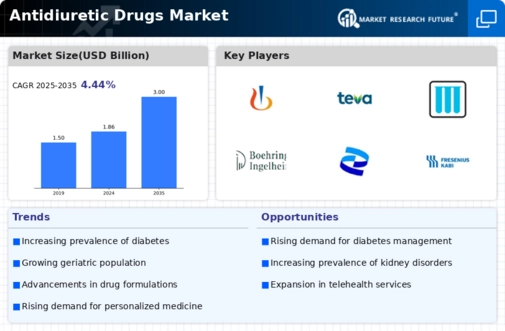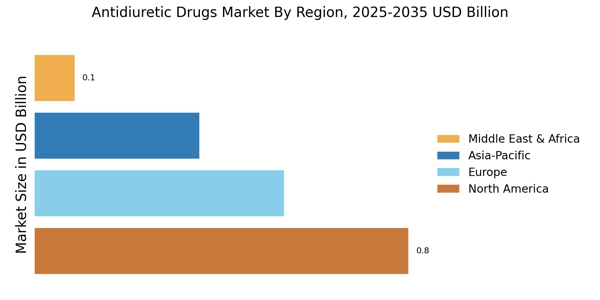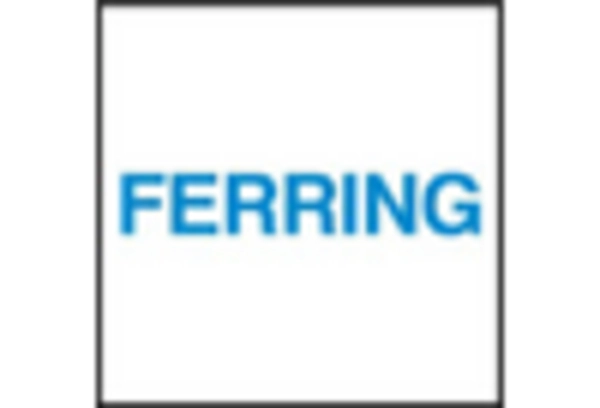Regulatory Support for Drug Approvals
Regulatory support for the approval of new antidiuretic drugs is a crucial driver for the Antidiuretic Drugs Market. Regulatory agencies are increasingly streamlining the approval process for innovative therapies, which may facilitate quicker access to new treatments for patients. This supportive environment encourages pharmaceutical companies to invest in research and development, leading to a more diverse range of antidiuretic medications entering the market. Additionally, favorable regulatory policies may enhance the market's attractiveness for investors, further stimulating growth. As new drugs receive approval and become available, healthcare providers will have more options to offer patients, potentially improving treatment outcomes and overall market dynamics.
Advancements in Pharmaceutical Research
Ongoing advancements in pharmaceutical research and development are poised to significantly influence the Antidiuretic Drugs Market. Innovative research methodologies and technologies are enabling the discovery of new antidiuretic agents with improved efficacy and safety profiles. For instance, the development of long-acting formulations and novel drug delivery systems may enhance patient adherence and therapeutic outcomes. Additionally, the integration of personalized medicine approaches could lead to more targeted therapies for individuals with specific needs. As a result, the market is likely to witness an influx of new products, which may stimulate competition among manufacturers and ultimately benefit patients through enhanced treatment options.
Growing Prevalence of Diabetes Insipidus
The rising incidence of diabetes insipidus, a condition characterized by excessive thirst and urination, is a primary driver for the Antidiuretic Drugs Market. This disorder can lead to significant health complications if left untreated, necessitating effective management strategies. According to recent estimates, the prevalence of diabetes insipidus is increasing, with a notable rise in cases attributed to genetic factors and other underlying health conditions. As healthcare providers seek to address this growing patient population, the demand for antidiuretic drugs, such as desmopressin, is expected to surge. This trend indicates a robust market potential, as pharmaceutical companies focus on developing innovative formulations and delivery methods to enhance patient compliance and treatment outcomes.
Aging Population and Associated Health Issues
The demographic shift towards an aging population is likely to have a profound impact on the Antidiuretic Drugs Market. Older adults are more susceptible to various health issues, including chronic kidney disease and other conditions that may lead to the need for antidiuretic therapy. As the global population aged 65 and older continues to grow, the demand for effective management of fluid balance disorders is anticipated to rise. This demographic trend suggests that pharmaceutical companies may increasingly focus on developing antidiuretic drugs tailored to the unique needs of elderly patients. Furthermore, the increasing prevalence of comorbidities in this age group may further drive the market, as healthcare providers seek comprehensive treatment options.
Rising Awareness of Fluid Management Disorders
There is a growing awareness of fluid management disorders among healthcare professionals and patients, which is likely to drive the Antidiuretic Drugs Market. Increased education and outreach efforts have led to better recognition of conditions such as diabetes insipidus and the importance of effective treatment. This heightened awareness is encouraging patients to seek medical advice and treatment options, thereby increasing the demand for antidiuretic drugs. Furthermore, healthcare providers are becoming more proactive in diagnosing and managing these disorders, which may lead to an uptick in prescriptions for antidiuretic medications. As awareness continues to rise, the market is expected to expand, with more patients receiving appropriate care.


















Leave a Comment